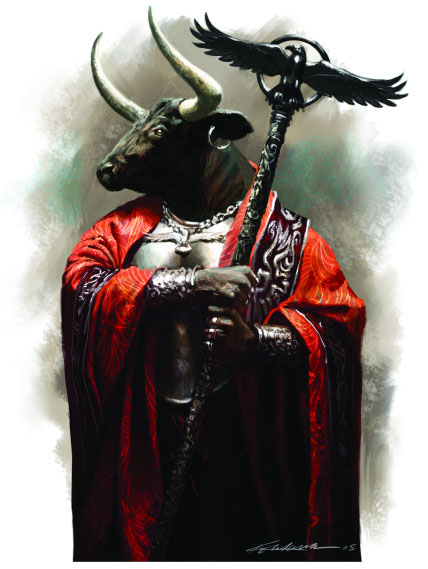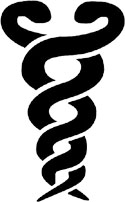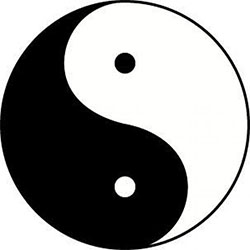
IN THE SHADOW OF THE SPIRE
HARVESTTIME – PART 2: DOMINIC AND THE GUIDANCE OF VEHTHYL
PBeM – November 12th through December 1st, 2007
Harvesttime in the 790th Year of the Seyrunian Dynasty
Although he didn’t speak of it to the others, the loss of his memory worried at Dominic’s soul. Given a day in which to pursue his own goals with a freedom of conscience, Dominic quickly ate his own breakfast and then headed towards the Temple District – intent on seeking out the guidance of Vehthyl, the god of mysteries whose strange holy symbol he had found upon awaking at the Ghostly Minstrel.
A THEOLOGICAL REVIEW
This is an opportune moment to review the major theological crisis of the current era: The conflict between the Imperial Church and the Reformists.
The Imperial Church is based out of Seyrun. Its history dates back to the 1st century YD (more than 700 years ago) when the varied Pantheon cults which emerged during the Wars of Empire were unified under the Novarch and the Councils. It was this unification which led to the creation of the modern doctrines (as preserved in the Nine Books: The Book of Athor, the Book of Crissa, and so forth).
The Imperial Church, although based out of Seyrun, rapidly spread throughout the Five Empires. It was soon embaced not only by Seyrun, but by Barund, Arathia, Hyrtan, and the Vennoc Protectorates.
Recently, however, this unity has been fracturing. During the most recent war between Barund and Seyrun, the Emperor used elements of the Church for espionage. The King of Barund responded by severing Seyrun’s control over Barund’s church. While the Barundian church remains technically part of the Imperial Church, this is largely a fiction (although one observed by both Seyrun and Barund). The reality is that the Barundian church is largely controlled by the King.
This fracture, however, is minor compared to the Reformist movement which began in Astalia (one of the Vennoc Protectorates). The Reformists are, in fact, hundreds of separate religions — all of them worshipping the Pantheon, but rejecting either the Imperial Church’s structure, doctrine, or both. The Reformists generally hold that the Church has lost its way and believe that the Nine Gods no longer speak through the Novarch. The Imperial Church, on the other hand, considers the Reformists to be heretics.
RELIGION IN PTOLUS
Which brings us to religion in Ptolus. One of the three merchant princes who journeyed to Seyrun, knelt before the novarch, and brought the Imperial Church back to Arathia came from Ptolus. As a result, the Outer Cathedral of Athor (one of the major churches) was built in Ptolus. There are also several smaller churches and chapels scattered throughout the city (including St. Gustav’s Chapel.)
Reformist churches in Ptolus are plentiful – so plentiful, in fact, that the Temple District (once named just for the Outer Cathedral) is now overflowing with them.
The most significant development among the Reformists of Ptolus are the Saint Cults (as the Imperial Church refers to them). These cults venerate the saints and Avatars as gods in their own right.
LOOKING FOR VEHTHYL
Dominic is (or at least was) a member of the Imperial Church. He is, in fact, from Seyrun, where the Imperial Church remains strongest. Since awaking in Ptolus, he has interacted with two religious figures: Brother Fabitor of St. Gustav’s Chapel (which is one of the Imperial Churches in Ptolus) and Mand Scheben of the Temple of Asche (a Reformist church venerating Asche, the Itehlen Saint of the City).
When Dominic headed across the bridge into the Temple District, he made gentle inquiries into the worship of Vehthyl and discovered four options:
First, the Order of the Silver God – an official religious order of the Imperial Church – maintained a small chapel and chapterhouse in the Temple District. They also controlled the Archives of the Church in Ptolus, which was located in the Outer Cathedral. The Order believed that the mysteries of sorcery and spellcraft should be dedicated wholly to the veneration of Vehthyl and ruthlessly seek out any who would use magic for an evil purpose.
Second, the Temple of the Clockwork God. Located on Chalice Road in the Temple District, this Reformist temple venerated Vehthyl in his aspect as the Clockwork God (in which his mysteries guide the hidden workings of the universe).
Third, the Temple of the Ebon Hand. A very small Reformist temple located on Terrock Road. In truth, it is little more than a chapel in which the Cult of the Ebon Hand reportedly worships both Bahl and Vehthyl with secretive rites.
And, finally, an itinerant minotaur priest named Shibata who wandered the streets of the Temple District and haunted various libraries around the city. Some of those whom Dominic spoke to distrusted Shibata completely, but others described him as a surprisingly gentle soul.
A CRISIS OF FAITH
Doubting that the Imperial Church would understand or believe his story, Dominic decided to seek out the Reformist Shibata.
It took a couple of hours asking around the Temple District, but he eventually found someone who said they had recently seen Shibata walking on Meditation Circle. Dominic learned that this was  over towards the western end of the district, and when he arrived he easily picked out the minotaur. Shibata was dressed in crimson robes inscribed with bands of silver runes in Sariel marking out Vehthylian prayers. The priest leaned upon a carven staff with an eagle for its head-piece (the eagle being the holy animal of Athor the Father), but as Dominic approach he straightened and looked at him.
over towards the western end of the district, and when he arrived he easily picked out the minotaur. Shibata was dressed in crimson robes inscribed with bands of silver runes in Sariel marking out Vehthylian prayers. The priest leaned upon a carven staff with an eagle for its head-piece (the eagle being the holy animal of Athor the Father), but as Dominic approach he straightened and looked at him.
“You seek me?”
Dominic nodded.
“Then walk with me.”
As they walked around Meditation Circle, Shibata listened to Dominic’s story and his plight. At the end of his, Dominic showed the holy symbol of Vehthyl that he awoke with: “By its design, can you tell anything about where it was made, or does it match any particular sect?”
Shibata reached out and took the symbol into the palm of his hand. He looked at it for a moment. Then he smiled, brought it to his lips, and kissed it. Letting it fall back against Dominic’s chest he said, “I am not a silversmith. But it is the serpent doubled – a symbol of balance within the order of the universe, but also the symbol of the known and the unknown facing each other. An apt symbol for a proper mystery.”

Shibata thought for a moment and – as he did – his weight found its way back onto his staff. Then he straightened again. “Let me show you two things and suggest a third.”
He continued walking along the Meditation Circle, but then took a turn to the left – along the sinuous path that led throug the center of the circle. Dominic realized that the entire circle formed the ancient Symbol of Balance.

As they reached the center of the circle, Shibata stopped and pointed to the northwest, towards a rather ramshackle building: “There is Denthor’s, a coffin-maker.” Then he pointed to the southwest: “There is the Temple of Excellence, a religion which worships no god at all but rather the perfection of the mortal form.” Then he pointed to the east, towards a domed tower flanked by tall obelisks: “And there is the Shrine of the Oracle, she who foretells the future.”
Shibata turned between the three points a second time: “Death. Life. And the Unknown.”
And he turned between them a third time: “Past, present, and future.”
He lowered his arm and turned to face Dominic, leaning forward on his staff. “No one planned it thus, yet thus it is.”
Shibata turned and began walking away from the Meditation Circle. He led Dominic west through the Temple District, and then across the bridge into Oldtown. The walk took the better part of half an hour, but through it all the priest didn’t speak a word.
They came to a place called Brightfather Street, and then turned aside into a narrow alley between tall buildings. They went down this alley and then another before Shibata finally came to a stop. He pointed towards a perfectly ordinary wall and said, “Look through this chink.”
Bending forward, Dominic saw a perfectly ordinary crack in a wall that had probably stood there for centuries. At best he thought that he might see through it and into the building on the other side. But as he put his eye to the chink he was greeted with an impossible sight – a strange desert with dunes of multi-colored sands that swept away towards a distant horizon.
He pulled back sharply, and then leaned forward to look again. Shibata smiled. “I found this place just a few days ago. A few days from now it may no longer exist. Or perhaps it will endure for all time. No man made it. Perhaps none even knew of it before I came here. This place is the very essence of Vehthyl. It is the mystery of life. Arcanists may feel that they master the ways of magic, but they do not. Magic is the way of mystery, and by its nature it cannot be mastered.”
Shibata paused and looked towards the sky. Then he looked back down to Dominic. “I do not have the answers you’re looking for. Perhaps none do. But have you given thought to prayer?”
Then he turned and walked away, leaning ever more heavily on his staff as he went.
Dominic stood in thought until Shibata had turned from the alley and disappeared from sight, and then he stood a good while longer. At last, having reached some inner resolution, he returned to his room at the Ghostly Minstrel.
There he knelt upon the floor in prayer and called aloud the name of Vehthyl.
…and his eyes glowed bright silver and all the world was touched by its light.











